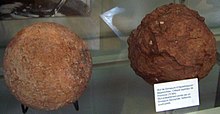Hypselosaurus
| Hypselosaurus | ||||||||||||
|---|---|---|---|---|---|---|---|---|---|---|---|---|
| Temporal occurrence | ||||||||||||
| Upper Cretaceous ( Maastrichtian ) | ||||||||||||
| 72 to 66 million years | ||||||||||||
| Locations | ||||||||||||
| Systematics | ||||||||||||
|
||||||||||||
| Scientific name | ||||||||||||
| Hypselosaurus | ||||||||||||
| Matheron , 1869 | ||||||||||||
| Art | ||||||||||||
|

Hypselosaurus is a genus of sauropod dinosaur from the group of Titanosauria .
So far fragmentary remains of at least 10 individuals have been assigned to this genus , which come from various sites in Spain and France and are dated to the Upper Cretaceous ( Maastrichtian ).
Hypselosaurus is now regarded as the noun dubium (dubious name), as the known skeletal material shows no diagnostically usable features, so it is not possible to differentiate it from other genera. The only species is Hypselosaurus priscus .
Research history, naming and eggs
Hypselosaurus was scientifically described in 1846 by geologist Pierre Émile Philippe Matheron on the basis of fossils from the French Rognac in Provence and named in 1869. Matheron thought this animal was a gigantic, aquatic crocodile; only Charles Depéret showed in 1900 that it was a sauropod. The name means something like "high lizard" ( Greek hypselos - "high", "sublime"; Greek sauros - "lizard") - Matheron chose this name to draw attention to the unusual long-leggedness of the supposed crocodile.
To date, a large number of fossil eggs have been ascribed to this genus - a tradition that can be traced back to Matheron. However, these assignments are based solely on the fact that the eggs come from the same rock layer as the Hypselosaurus bones. Today's researchers consider the assignment of the eggs to Hypselosaurus to be untenable.
Individual evidence
- ↑ a b Hypselosaurus. In: The Paleobiology Database. Retrieved August 28, 2014 .
- ^ A b Paul Upchurch , Paul M. Barrett , Peter Dodson : Sauropoda. In: David B. Weishampel , Peter Dodson, Halszka Osmólska (eds.): The Dinosauria . 2nd edition. University of California Press, Berkeley CA et al. 2004, ISBN 0-520-24209-2 , pp. 259-324.
- ^ A b Jean Le Loeuff: Osteology of Ampelosaurus atacis (Titanosauria) from Southern France. In: Virginia Tidwell, Kenneth Carpenter (Eds.): Thunder-lizards. The Sauropodomorph dinosaurs. Indiana University Press, Bloomington IN et al. 2005, ISBN 0-253-34542-1 , pp. 115-137.
- ^ Philippe Matheron: Sur les terrains traversés par le souterrain de la Nerthe, près Marseille. In: Bulletin de la Société géologique de France. Série 2, Vol. 4, Issue 2, 1846, ISSN 0037-9409 , pp. 261-269, digitized .
- ↑ Philippe Matheron: Note sur les reptiles fossiles des dépôts fulvio-lacustres crétaces du bassin à lignite de Fuveau. In: Bulletin de la Société géologique de France. Série 2, Vol. 26, 1869, pp. 781-795, digitized .
- ↑ Ben Creisler: Dinosauria Translation and Pronunciation Guide ( Memento October 13, 2011 in the Internet Archive ).
- ↑ Éric Buffetaut , Jean Le Loeuff: The discovery of dinosaur eggshells in nineteenth-century France. In: Kenneth Carpenter, Karl F. Hirsch, Jack Horner (Eds.): Dinosaur Eggs and Babies. Cambridge University Press, Cambridge 1994, ISBN 0-521-44342-3 , p. 31.